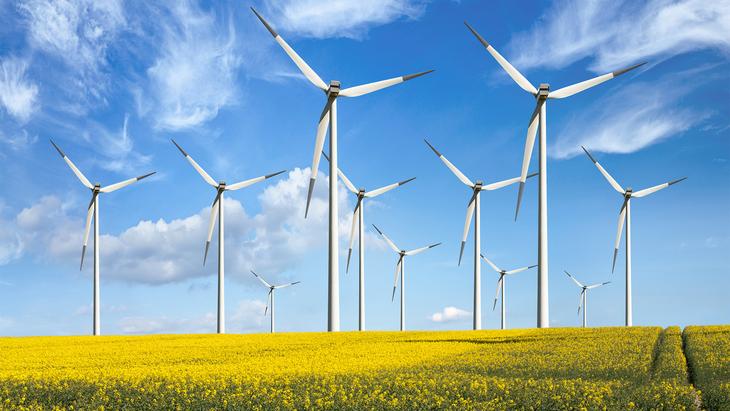Between January 2023 and August 2023, AIT – Austrian Institute of Technology, REKK – Regional Centre for Energy Policy Research, and EFdeN, together with input from local stakeholders, worked on a study that mapped the existing wind potential in Romania (the full report can be accessed here). Specifically, the study details the onshore wind capacity for our country. By applying spatial constraints and an approach focused on optimizing the financial efficiency of projects, exploiting the capacity from only the five counties with the highest potential (approximately 48.1 GW), we could generate twice as much energy (approximately 122.6 TWh) as Romania’s current electricity consumption (61 TWh in 2021).
The study’s data show that Romania has a significant capacity to generate electricity from onshore wind energy sources without endangering biodiversity and protected natural areas. The study identifies several favorable regions for the development of such projects, especially in the counties of Constanța, Tulcea, Brăila, Galați, and Ialomița, which have a combined capacity of around 10 GW, even with spatial constraints and excluding protected natural areas. In practice, harnessing the potential in just one county would allow for the generation of 10 out of the 11.69 TWh that Romania has committed to achieving by 2030 under the National Integrated Energy and Climate Change Plan (PNIESC).
Within the study, a Geographic Information Systems (GIS) analysis was conducted, taking into account various factors such as the region’s meteorological data, spatial constraints that can affect wind park development (e.g., built-up areas, agricultural land, natural reserves, etc.), key input parameters (distance regulations, turbine design, economic limits, etc.), and how the identified wind energy development potential aligns with the existing or planned network infrastructure. Additionally, an analysis was carried out on how the development of wind energy projects could impact the electricity market.
The study also indicates that the restriction of renewable energy sources (RES) in Romania is generally insignificant in the years 2030 and 2040 but increases significantly by 2050, varying considerably depending on the level of wind energy penetration into the grid. Furthermore, the study highlights the impact on electricity exports and the need for sufficient reserves to manage fluctuations resulting from wind energy generation. As for CO2 emissions, they are decreasing, and the differences in impact between the three scenarios analyzed vary based on the years considered.
The preliminary results of the study were presented during the study dissemination event on the wind potential in Romania, Bulgaria, and Hungary on Friday, October 20, 2023, at EFdeN, located within the Technical University of Civil Engineering in Bucharest, Faculty of Building Services Engineering, 66 Pache Protopopescu Boulevard, Sector 2, Bucharest. The event also took place at the Ministry of Environment, Water, and Forests, as part of the Climate Change Summit.
Together with key stakeholders, representatives from the public administration, and civil society organizations, the event addressed the directions for the study’s evolution and development, as well as the real needs for increasing renewable energy production capacity, especially in wind energy. A wind energy working group was formed to further explore the study’s themes.
The event was attended by representatives from the Romanian Wind Energy Association (RWEA), the World Bank, the European Commission, WWF, Greenpeace, FEL Romania, Energy Policy Group, and private companies in the energy sector.
“We are glad to see that the sector’s development is further supported with analytical work like what you’ve discussed during this roundtable. This is, of course, a key prerequisite in addressing the major challenges, but also in using the opportunities that the energy transition brings,” said Ivan Krofak, Energy Expert, World Bank.
“The RWEA (Romanian Wind Energy Association) welcomes the initiative to conduct this study and appreciates the efforts of the creators. It is an extremely valuable study for the development of the wind energy industry in Romania. We are pleased to see that our country’s wind potential is well highlighted in the southeastern European region, which strengthens our belief that Romania can become a regional hub for the entire value chain of this industry, contributing to the country’s economic growth. Furthermore, this study can be seen as an important starting point for the Romanian state in the process of defining the so-called Renewables Acceleration Areas, a concept introduced by the Renewable Energy Directive III, recently adopted at the European authorities in Brussels,” added Georgiana Toma, Regulations Working Group Coordinator, RWEA.
“The overall potential for wind energy, both onshore and offshore, in Romania is significant in terms of energy, being twice as high as the current total electricity consumption. The expected market impacts are generally promising, as an increase in the utilization of wind energy could go hand in hand with a decrease in wholesale prices in Romania and contribute to Romania’s fight against climate change, leading to further reductions in carbon emissions in the coming years,” also said Gustav Resch, Senior Researcher, AIT.
